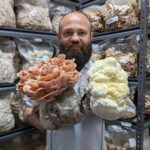Getting your mind around mushrooms can be complicated! Here is a little guide to some of the terminology commonly used in the world of mushrooms.
Terminology
Abort – A mushroom that for some reason does not reach maturity.
Colonization – This is the process of the mycellium growing onto its substrate. As it “colonizes” the substrate it converts the carbon and nutrients into its tissues. It also produces antibiotics and other compounds to prevent other organisms from competing with it.
Culture – A culture is a specific strain of a fungus growing on a Petri plate.
Flush – A flush is a fruiting event in which a single, various, or a cluster of mushrooms are produced.
Fruiting – Fruiting refers to the growth of the reproductive structure we know as mushrooms. Due to some resemblance with fruits, it is described as fruiting.
Fruiting Chamber – This is a special container used for fruiting mushroom kits. It helps increase humidity while allowing appropriate air exchange.
Inoculation – This is the process of introducing fungal mycellium into a new growth medium. For example, when making a grow kit you “inoculate” your substrate with spawn.
Incubation – Incubation is the time allowed for mycellium to colonize the substrate. It is essentially the growth phase of the mycellium
Liquid Culture – This is mycellium cultivated within a liquid growth medium. This is typically used for the production of spawn
Substrate – Substrate is a growth medium used in mushroom cultivation. Bulk-substrate is a term used to describe the final growth medium used when making a mushroom kit
Mycelium – This is the filamentous spider-web growth of the fungus. You can see this in the wild growing within the leaf litter or on fallen logs.
Mushroom Kit – This is how most gourmet mushrooms are cultivated. They are typically made of specialized mushroom grow bags filled with processed substrate and spawn.
Mycology – Is the science revolving around the study of fungi
Pins or Primordia – These are the small mycellium structures that appear at the beginning of the fruiting process. They are usually just small “pins” when they start, hence the common name.
Pasteurization – This is a process conducted to remove or eliminate most microorganisms from a substrate. This is most commonly conducted with hot temperatures or lime.
Sterilization – Sterilization resembles pasteurization but is more intensive. Its goal is to eliminate 99.9% of all microorganisms from the substrate. Sterilization is most often conducted with high heat and pressure as can be achieved with pressure cookers or auto-clave. Sterilization is used for the production of spawn, liquid cultures, or when using supplemented substrates.
Spawn – This is a material used for the process of inoculating a bulk substrate. It is typically made from grain or sawdust. It requires sterilization and must be inoculated under laboratory-like conditions.
Spores – Spores are the microscopic “seed-like” structures produced from mushrooms. These are dust-like and float in the air. They actually are more similar to pollen as they only contain half the genetic information of a mature individual.
Former owner of That Mushroom Guy, which was acquired by Rootlab in September 2025.


